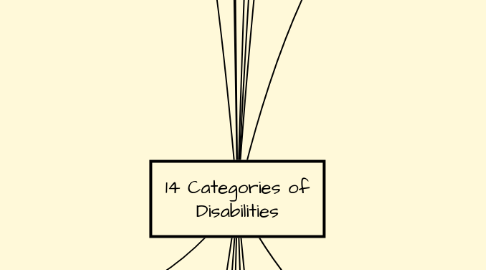
1. Developmental Delay
1.1. intervention/modifications
1.1.1. Counseling
1.1.2. Nutritional modifications
1.1.3. Plans for families at home
1.1.4. Longer time to complete tasks
1.1.5. Working in small groups
1.2. assistive technology
1.2.1. Ebooks
1.2.2. Memory games
1.2.3. Ipads
1.2.4. Smart boards
1.2.5. Apps that help stimulate learning
1.2.6. Physical play games
2. Emotional Disturbance
2.1. intervention/modifications
2.1.1. Counseling
2.1.2. Behavior plans
2.1.3. Set goals
2.1.4. Total classroom inclusion
2.1.5. Parent/teacher communication
2.1.6. Have clear rules and guidelines
2.2. assistive technology
2.2.1. Music
2.2.2. Computer and Video games
2.2.3. Ipad
2.2.4. Apps
2.2.5. Calming voice
2.3. Case Study
2.3.1. http://ed.psu.edu/englishpds/10-11/gerrity/Case_Study_files/Gerrity-CaseStudy.pdf
3. Intellectual Disability
3.1. intervention/modifications
3.1.1. IQ tests
3.1.2. Simplify material or tasks
3.1.3. Make questions easier
3.1.4. Make material more interesting
3.2. assistive technology
3.2.1. Ipads
3.2.2. Alternate computers for people with disabilities
3.2.3. Special software for learning
3.2.4. Learning devices with large buttons
4. Orthopedic Impairment
4.1. intervention/modifications
4.1.1. Special seating
4.1.2. Extra time to complete tasks
4.1.3. Make materials easier to use
4.1.4. P.T.
4.1.5. Modified physical activities
4.1.6. Assistance with in class work
4.2. assistive technology
4.2.1. Helpful software
4.2.2. Screen readers
4.2.3. Speech recognition
4.2.4. Large buttons on electronics
5. Speech or Language Impairment
5.1. intervention/modifications
5.1.1. Provide extra help
5.1.2. Give the student a head-start with materials
5.1.3. Speak in even tones
5.1.4. Use simple words
5.1.5. Tutoring
5.1.6. More time to complete tasks
5.1.7. Give oral assignments
5.2. assistive technology
5.2.1. Specialized computer software
5.2.2. Communication aids
5.2.3. Sign language classes
6. Visual Impairment including Blindness
6.1. intervention/modifications
6.1.1. Sit at the front of class
6.1.2. Make words bigger
6.1.3. Practice Braille
6.1.4. Provide extra material or notes
6.1.5. Give extra time
6.1.6. Have an eye exam
6.2. assistive technology
6.2.1. Books with large fonts
6.2.2. Apps with large fonts
6.2.3. Braille printers
6.2.4. Talking electronics
7. Multiple Disabilities
7.1. intervention/modifications
7.1.1. One on one help
7.1.2. Non restrictive environment
7.1.3. Inclusion in class
7.1.4. Classroom positioning
7.1.5. Evaluations
7.2. assistive technology
7.2.1. Braille
7.2.2. Hearing aide
7.2.3. Memory games
7.2.4. Voice recognition
7.2.5. Specialized materials
8. Autism
8.1. intervention/modifications
8.1.1. Routine
8.1.2. Set comfort levels
8.1.3. Healthy environment
8.1.4. Teacher training
8.1.5. Parent communication
8.1.6. Help other students to understand
8.1.7. Evaluate needs
8.1.8. Assistant help
8.2. assistive technology
8.2.1. Memory games
8.2.2. Ipads
8.2.3. Smart boards
8.2.4. Computers
8.2.5. Interactive support software
8.3. Case study
8.3.1. http://www.slideshare.net/TahminaSultana/autism-case-study
9. Deaf - Blindness
9.1. intervention/modifications
9.1.1. Repeat instruction
9.1.2. Learn Braille
9.1.3. Lip reading
9.2. assistive technology
9.2.1. Implants
9.2.2. Braille printers
10. Deafness
10.1. intervention/modifications
10.1.1. Visual help
10.1.2. Repeated instruction
10.1.3. Extra materials
10.1.4. Sign language
10.1.5. Group instruction
10.1.6. Screenings
10.1.7. Priority seating
10.2. assistive technology
10.2.1. Closed captioning
10.2.2. Hearing aide
10.2.3. Visual cues
11. Hearing Impairment
11.1. intervention/modifications
11.1.1. Seating near teacher or activity
11.1.2. Screenings
11.1.3. Have a quiet environment
11.1.4. Give extra time
11.1.5. Check understaning
11.1.6. Sign language
11.2. assistive technology
11.2.1. Hearing aide
11.2.2. Sign language
11.2.3. Closed Captioning
11.3. Case Study
11.3.1. http://wps.ablongman.com/wps/media/objects/423/433278/13%20HS%20Case%20Studies.pdf
12. Other Health Impairment
12.1. intervention/modifications
12.1.1. Research specific impairment
12.1.2. Medications
12.1.3. Seating at the front
12.1.4. Have private discussions
12.1.5. Give less homework
12.1.6. Keep students involved in all class aspects
12.1.7. Evaluations
12.1.8. Communicate with the doctor
12.1.9. Teacher training
12.2. assistive technology
12.2.1. Inhalers
12.2.2. Medicines
12.2.3. Alarms for scheduling
12.2.4. Audio books
12.2.5. Helpful techniques to halt problems
13. Specific Learning Disability
13.1. intervention/modifications
13.1.1. Evaluation
13.1.2. Break instructions down
13.1.3. Allow time to complete tasks
13.1.4. Training to help
13.1.5. Safe environment
13.1.6. Outlines approach
13.2. assistive technology
13.2.1. Ereaders
13.2.2. Apps
13.2.3. Voice recognition software
14. Traumatic Brain Injury
14.1. intervention/modifications
14.1.1. Extra time to finish work
14.1.2. Recording of materials covered for later use
14.1.3. Seating at the front
14.1.4. Classroom buddy system for help
14.1.5. Continuous Evaluations
14.1.6. Give breaks when students are frustrated
14.2. assistive technology
14.2.1. Talking electronics
14.2.2. Memory games
14.2.3. Counseling
14.2.4. Large button electronics
14.2.5. Ereaders
